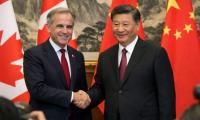A statistical overview of China’s unparalleled achievements
In 2020, China exported approximately US$2.6 trillion worth of goods, making it the world’s largest exporter
LAHORE: While China has already overtaken the United States in terms of national net worth to grab the top spot worldwide, courtesy a red-hot real estate market that drove up property values, the size of this Communist nation’s economy is also expected to surpass that of America by 2033.
“The Nikkei,” world's largest financial newspaper with a daily circulation exceeding three million, writes: “China's net worth reached $120 trillion in 2020 to overtake the US's $89 trillion as a red-hot real estate market drove up property value, according to a report by McKinsey Global Institute. The McKinsey report covered 10 countries that account for 60% of the world's income.”
The Tokyo-based publication adds: “The total net worth for the group tripled from 2000 to $510 trillion. China's net wealth -- the value of total assets minus liabilities -- rose by a factor of 17 from $7 trillion two decades earlier. The country accounted for 23% of the total in 2020, while the US's share was 17%, followed by Japan, which accounted for 7%, at $35 trillion.”
Remember, the Japan Center for Economic Research had predicted a year ago that China would outshine the American economy by 2029. Similarly, on Dec 26, 2020, the “BBC News” had maintained: “China will overtake the US to become the world's largest economy by 2028, five years earlier than previously forecast, a report says. The UK-based Centre for Economics and Business Research (CEBR) said China's "skillful" management of Covid-19 would boost its relative growth compared to the US and Europe in coming years. Although China was the first country hit by Covid-19, it controlled the disease through swift and extremely strict action, meaning it did not need to repeat economically paralysing lockdowns as European countries have done. As a result, unlike other major economies, it has avoided an economic recession in 2020 and is in fact estimated to see growth of 2% this year.”
However, a New York-based American newspaper “The Wall Street Journal” has viewed: “China is experiencing a slow-motion economic crisis that could undermine stability in the current regime and have serious negative consequences for the global economy. The US and its allies have many tools to influence China’s economy and need to weigh the consequences of an acute crisis against the threat its current trajectory poses to the US policy makers should be thinking of how best to deploy these tools, instead of passively assuming the rapid growth and stability of the Chinese economy will continue.”
Having a circulation of about 2.834 million copies (including nearly 1,829,000 digital sales) as of August 2019, this leading US media house has further opined: “In December real-estate developers China Evergrande and Kaisa joined several other overleveraged firms in bankruptcy, exposing hundreds of billions in yuan- and dollar-denominated debt to default. Real estate represents around 30% of the Chinese economy, nearly twice the levels that led to the financial crisis of 2008-09 in the US, Spain and England.
More Chinese accomplishments:
With a population of more than 1.4 billion, China spans five geographical time zones and borders 14 different countries, the second most of any country in the world after Russia.
China, which was regarded as the world second wealthiest country sometime back, is the world's largest economy by GDP at Purchasing Power Parity (US$26.66 trillion) and the second largest economy by Nominal GDP (US$16.64 trillion).
(Reference: Latest IMF reports)
Nuclear power China is the world's largest manufacturer.
According to the Chinese Ministry for Industry and Information Technology, from 2012 to 2020, China's industrial value-added grew from 20.9 trillion yuan ($3.24 trillion) to 31.3 trillion yuan, of which the manufacturing value-added grew from 16.98 trillion yuan to reach 26.6 trillion yuan.
In 2020, China exported approximately US$2.6 trillion worth of goods, making it the world’s largest exporter.
On July 9, 2021, German data website “Statista,” had revealed: “China has become the largest manufacturing economy and the largest exporter in the world.” By the way, China has the world's largest-standing Army by military personnel.
On October 29, 2021, the “Al-Jazeera Television” had reported: “Once hailed by the Communist Party as having defeated past adversaries with only “millet plus rifles”, the People’s Liberation Army has now grown into the world’s largest fighting force, with more than two million active personnel. Their air force has also grown into the largest in the Asia-Pacific region and the third largest in the world, with more than 2,500 aircraft and roughly 2,000 combat aircraft, according to an annual report by the US’s Office of Secretary of Defense published last year.”
The latest “Pentagon-China Military Power Report” reads: “Within its ranks, there are more than 915,000 active-duty troops in its ranks, dwarfing the US, which has about 486,000 active soldiers.”
According to the Stockholm International Peace Research Institute, China’s weapons exports went mostly to Pakistan, Bangladesh, and Algeria over the past decade.
The Swedish institution further propounded: “Over the same time period, China has also been one of the world’s leading exporters of armed unmanned aerial vehicles (UAVs), commonly known as drones, with customers, including the United Arab Emirates and Saudi Arabia.
Moreover, China has the second-largest defence budget too. According to an “Al-Jazeera Television” report, for fiscal 2021, 1.36 trillion yuan (roughly $209.16 billion) was allocated to defence — 6.8 percent more than last year. The Chinese defence budget was $252 billion in 2020, according to the Stockholm International Peace Research Institute.
China has become a central player in writing international rules for emerging technologies, particularly fifth-generation wireless, as part of a national effort to shape the playing field in its favour.
By April 2020, China had surpassed the United States to lead the world in international patent applications for the first time, while telecommunications giant Huawei Technologies topped the list of companies for a third straight year, the World Intellectual Property Organization revealed in Geneva.
(Reference: The Nikkei Asia)
On Feb 25, 2021, the globally-acclaimed German company specializing in market and consumer data, Messrs Statista, had revealed: “In 2019, there were around 13 million mobile 5G subscriptions worldwide, which was forecasted to surge to almost two billion by 2024. Among all the countries in the world, China was forecasted to lead the way in terms of the number of 5G connections throughout the next five years, where the market revenue will skyrocket from 0.6 trillion Yuans to over six trillion Yuans in this decade.”
In September 2021, the Chinese Ministry for Industry and Information Technology had claimed: “China has built more than one million 5G base stations, accounting for more than 70 percent of the world's total, and 5G terminal users in China have exceeded 400 million who consist of the world's largest user group.”
Chinese interests in Afghanistan:
Since 2010, China has increased its economic aid and investment in Afghanistan, notably with announcement by Metallurgical Corporation of China pledging $3.5 billion to develop Aynak Copper mines. China has since been mining copper outside of Kabul.
An eminent website “Energy Post,” which primarily reports on the European and international energy sector, states that China had lent $240 million in aid and pledged a similar amount over the next four years between 2012 and 2013.
In September 2021, China had pledged some 200 million Yuans ($31m, £22m) worth of aid to Afghanistan, including food supplies and coronavirus vaccines.
(Reference: BBC News)
According to an Oct 13, 2021 report of the Washington Institute for Near East Policy, China is no newcomer to the Afghan-Pak region. It shares a 57-mile-long border with Afghanistan.
This prestigious American policy think-tank asserts: "To date, China has invested an estimated US$60 billion in CPEC-related ventures. But despite significant setbacks, the country has achieved with CPEC what the mighty Soviet Empire arguably wanted when it invaded Afghanistan -- an outlet to the Arabian Sea and the Indian Ocean. Thus, securing its assets in Pakistan is of critical interest for China."
-
 Canadian PM Visits China After A Decade Of Diplomatic Strain: What Deals Are In Focus?
Canadian PM Visits China After A Decade Of Diplomatic Strain: What Deals Are In Focus? -
 New York Plans Limited Rollout Of Self-driving Taxis
New York Plans Limited Rollout Of Self-driving Taxis -
 Sarah Ferguson Faces Painful Choice Between Peace, Family Bond
Sarah Ferguson Faces Painful Choice Between Peace, Family Bond -
 Nvidia Clarifies ‘no Upfront Payment Needed For H200 Chips Production’
Nvidia Clarifies ‘no Upfront Payment Needed For H200 Chips Production’ -
 Africa First: Nigeria Set To Approve Landmark AI Rules For Digital Economy
Africa First: Nigeria Set To Approve Landmark AI Rules For Digital Economy -
 WhatsApp Tests Built-in Supervision Feature Long Missing From The App
WhatsApp Tests Built-in Supervision Feature Long Missing From The App -
 Iceberg A-23A Turns Blue As Scientists Warn Collapse Is Imminent
Iceberg A-23A Turns Blue As Scientists Warn Collapse Is Imminent -
 FIFA Selects Stats Perform For Betting Data And Live Streaming
FIFA Selects Stats Perform For Betting Data And Live Streaming -
 Is Jessica Simpson Really Joining 'The Bachelorette'?
Is Jessica Simpson Really Joining 'The Bachelorette'? -
 Brayden Point Injury Raises Concern After Early Exit For Tampa Bay Lightning
Brayden Point Injury Raises Concern After Early Exit For Tampa Bay Lightning -
 Meghan Trainor Addresses 'toxic Mom Group' Rumours Again
Meghan Trainor Addresses 'toxic Mom Group' Rumours Again -
 Mattel Autistic Barbie Doll Aims To Boost Representation And Inclusion
Mattel Autistic Barbie Doll Aims To Boost Representation And Inclusion -
 William Makes Calculated Move To Future-proof His Public Role Amid Harry Return
William Makes Calculated Move To Future-proof His Public Role Amid Harry Return -
 Elijah Wood Breaks Silence On Possible Return To New 'Lord Of The Rings' Film
Elijah Wood Breaks Silence On Possible Return To New 'Lord Of The Rings' Film -
 Aaron Rodgers Wife: What The NFL Quarterback Has Said About His Marriage
Aaron Rodgers Wife: What The NFL Quarterback Has Said About His Marriage -
 Buckingham Palace Shuts Down Claims It Can Step In On Harry’s Security
Buckingham Palace Shuts Down Claims It Can Step In On Harry’s Security




